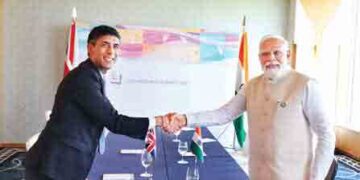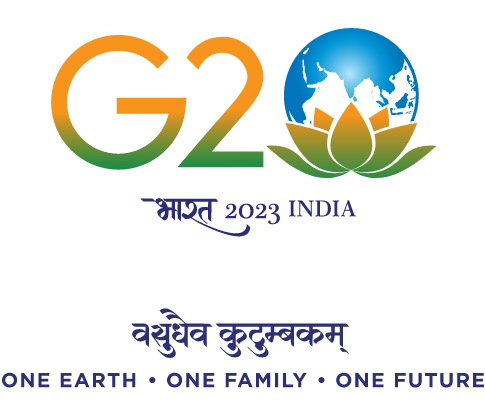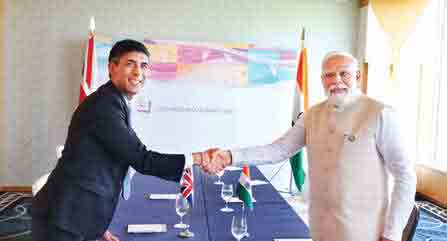 NDIA and the UK relations today stand on the cusp of transformation. A highly educated and economically dynamic 1.6 million Britons of Indian origin form a living bridge, as stated by Prime Minister Narendra Modi. His joint vision statement of May 2021, with the then British PM Boris Johnson, aims to position the two nations for a qualitative leap in ties by 2030.
NDIA and the UK relations today stand on the cusp of transformation. A highly educated and economically dynamic 1.6 million Britons of Indian origin form a living bridge, as stated by Prime Minister Narendra Modi. His joint vision statement of May 2021, with the then British PM Boris Johnson, aims to position the two nations for a qualitative leap in ties by 2030.
The UK and India have always formed a perfect and natural fit because both are modern, open and democratic societies. The emotional attraction for London and the familiarity with the language is such that it is invariably in the bucket list of must-travel destinations of every Indian.
From trade to defence & security, financial innovation to movement of young professionals, and cricket to music, the recent multiple layers of engagement between the two nations reflect their intensity and desire to catalyse an all-round improvement in ties.
FTA biggest fillip: Perhaps the biggest fillip would come from the Free Trade Agreement. Earlier this month, the ninth round of negotiations was concluded.
Unlike in the earlier times, both deeply feel the need for a FTA to boost the prosperity of their people through trade at a time when there is a slowdown in global trade due to the blowback from the Russian invasion of Ukraine. The FTA will not just inject an element of trust and simplify trade. Both countries will also gain from the interlocking FTAs they are simultaneously negotiating with Canada, Israel, the Gulf Cooperation Council, Australia and New Zealand.
On the margins, equally crucial but less headline-grabbing initiatives are bearing fruit. The Indian stock market is rapidly becoming more transparent and alert, thanks to the training being offered to the Indian regulator Sebi officials on the nuances of insider trading, market abuse and corporate governance.
India-UK relations ON THE CUSP of transformation
UK’s first Tech Envoy
UK’s first Tech Envoy
This technology and technological cooperation is not confined to training sessions. On a visit to India earlier this year, British Foreign Secretary James Cleverly announced the creation of the UK’s first Tech Envoy to the Indo-Pacific region, which will boost ties with India as a priority.
British PM Rishi Sunak will also recall the new infrastructure finance and policy partnership he signed as Chancellor of the Exchequer with Indian counterpart Nirmala Sitharaman to execute investments worth $1.4 trillion in India’s ambitious National Infrastructure Pipeline. Sunak had also inked pacts to give life to the vision of PM Modi to make the GIFT City (Gujarat International Finance TecCity) in Ahmedabad a world-class centre of global centre of finance.
Joint military exercises
The joint military exercises have moved on from the ritualistic aggregation of a few frigates to a tri-service affair that involves all the three armed forces. The IndiaUK Joint Tri-Service exercise ‘Konkan Shakti’ saw advanced warfare tactics and other complex manoeuvers at sea. In air, British F35Bs and IAF’s MiG 29Ks jointly conducted tactical operations.
Defence cooperation is moving from a simple seller-buyer interrelation to joint work on maritime propulsion system and complex weapons. As climate change begins to be more acutely felt, the UK and India are stepping up collaboration on low carbon transition through renewables and power, and to explore joint work on green hydrogen.
A strategic dialogue for an in-depth exchange of views has started between the Defence Ministers. The common priority is not to just to maintain freedom of operations in the contested IndoPacific region but also extend the concept to Africa, the Caribbean and Pacific Island States. All of the latter are India’s priority areas under the new SAGAR doctrine announced by PM Narendra Modi. Notably, PM Modi just visited a Pacific Island country and President Droupadi Murmu travelled to the Caribbean which was extensively worked over by External Affairs Minister S Jaishankar last month.
Exchange programme
For the first time for any country, UK launched a programme to enable young professionals from both countries to live, study, travel and work for up to two years in each other’s country. Over 2,000
randomly-selected young Indians with a degree will get to benefit. The peopleto-people ties need no reiteration. It is reflected by six Deputy High Commissions in Mumbai, Ahmedabad, Chennai, Bengaluru, Hyderabad and Kolkata, the highest for any country in India! The aspiration for closer ties has been forged by the trust generated during the Covid-19 pandemic. A household name in India during that period – the Covishield vaccine – was a product of collaboration between Oxford, Astra Zeneca and Serum Institute of India.
More work, more trust
The prospects are rosy but more hard work is in offing to generate more trust. Britain has learnt to live with India’s views on the conflict in Ukraine. But it must comprehend more acutely India’s requirements in areas of legitimacy and sovereignty. The lax response by London Police to the vandalising of the Indian High Commission left the Indian side deeply dissatisfied. Several meetings between NSAs Ajit Doval and Tim Barrow have still not brought about a closure to the Khalistani aggression brought to bear against Indian political and cultural symbols.
The continued sojourn in the UK of economic offenders Vijay Mallaya, Nirav Modi et al is a sore point in New Delhi’s South Block. Also some initiatives have floundered. Initiatives moribund for three years include the `Konkan Shakti’ triservices exercise, the space dialogue and the finalisation of a military logisticssharing agreement.
Despite these irritants, it is noteworthy that the India-UK strategic goal has remained constant though PMs in Britain changed rapidly. The framework has been defined by the 2030 Roadmap for India UK relations which was agreed upon by Indian PM Modi and the then UK PM Boris Johnson, in May 2021. Over 18 pages of text, it aims to steer cooperation for the next 10 years. The script so far is following the text.
















